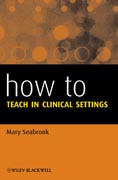
How to Teach in Clinical Settings is a practical guide to support all doctors wishing to develop their skills in clinical teaching and supervision. It provides hands on strategies to address common problems such as giving critical feedback effectively and teaching mixed–level groups. It gives guidance on the particular challenges of teaching in clinical settings including the need to manage teaching with service provision, to engage patients, motivate students, and to judge the balance of support and independence appropriate for each trainee. How to Teach in Clinical Settings is invaluable for all doctors involved in teaching and training at any stage of their career. It is also useful and accessible to medical students who increasingly need to consider and develop their own teaching skills as part of their career progression. INDICE: INTRODUCTION 1.CREATING AN EFFECTIVE LEARNING ENVIRONMENT Creating an effective learning climate Design of clinical placements Continuity between learners, teachers and patients Teaching and Learning Resources The teaching climate Involving patients in teaching General principles Involving other disciplines in teaching Learning/Teaching Opportunities Some principles of effective clinical teaching Useful strategies for clinical teaching Five tips for clinical teaching which don’t take time or money 2. TEACHING IN CLINICAL CONTEXTS Teaching on Ward Rounds General principles Useful strategies The psychiatric ward round Handover meetings, board rounds and bench rounds Bedside Teaching Preparation Structure for bedside teaching Feedback at the bedside Useful Strategies Teaching in Clinics General Principles Useful Strategies i. With trainees in parallel clinics Useful Strategies ii. Where students or trainees are supernumerary Teaching in the Accident & Emergency department Teaching the interpretation of images/specimens General Principles Teaching in Theatre General Principles Useful Strategies Teaching Practical Skills On–call/remote teaching Useful Strategies Teaching patients Useful Strategies Teaching other disciplines Issues to consider Strategies 3. WORKPLACE–BASED ASSESSMENT AND FEEDBACK The workplace–based assessments/supervised learning events Using the tools effectively Case–based Discussion (CbD) The Mini–Clinical Evaluation Exercise (Mini–ACE in psychiatry) Directly Observed Procedural Skills (DOPS) Multi–source Feedback (MSF) Teaching Assessment Tools Giving Feedback Giving Negative Feedback General Principles Useful strategies for giving feedback Structures for giving feedback Pendleton’s Rules Sandwich Model Other options 4.COMMON PROBLEMS IN CLINICAL TEACHING Balancing teaching and service demands Pitching teaching at the right level Dealing with complaints and clinical incidents Ad hoc teaching Teaching people at different levels together Teaching older or more experienced colleagues Engaging the quiet or reluctant learner The difficult consultation Teaching multiple students Teaching trainees with no interest in your specialty 5.NEXT STEPS Developing as a Teacher Evaluating your teaching Useful Resources Glossary of Assessment Tools INDEX
- ISBN: 978-1-118-62093-9
- Editorial: Wiley–Blackwell
- Encuadernacion: Rústica
- Páginas: 136
- Fecha Publicación: 20/12/2013
- Nº Volúmenes: 1
- Idioma: Inglés
